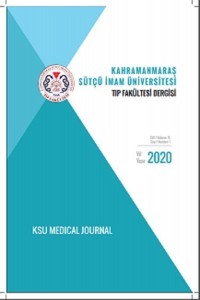Üriner Sistem Taşlarının Kimyasal Bileşiminin Yaş ve Cinsiyete Göre İncelenmesi
FT-IR spektrofotometre, taş analizi, üriner sistem taşları
Investigation of the Chemical Composition of Urinary System Stones According to Age and Gender
FT-IR spectrophotometer, stone analysis, urinary system stones,
___
- Singh VK, Rai PK. Kidney stone analysis techniques and the role of major and trace elements on their pathogenesis: A review. Biophysical reviews 2014;6(3):291-310.
- Tefekli A, Tok A, Altunrende F, Barut M, Berberoğlu Y, Müslümanoğlu AY. Üriner sistem taş hastalarında yaşam tarzı ve beslenme alışkanlıkları. Türk Üroloji Dergisi/Turkish Journal of Urology 2005;31(1):113-118.
- Turk C, Petřik A, Sarica K, Seitz C, Skolarikos A, Straub M et al. EAU Guidelines on Interventional Treatment for Urolithiasis. Eur Urol. 2016;69:475–482.
- Khalili P, Jamali Z, Sadeghi T, Esmaeili-Nadimi A, Mohamadi M, Moghadam-Ahmadi A, et al. Risk factors of kidney stone disease: a cross-sectional study in the southeast of Iran. BMC Urology 2021;21(1):1-8.
- Romero V, Akpinar H, Assimos DG. Kidney stones: a global picture of prevalence, incidence, and associated risk factors. Reviews in Urology, 2010;12(2-3):86-96.
- Basiri A, Shakh SN, Khoushdel A, Pakmanesh H, Radfar MH. Drinking water composition and incidence of urinary calculus introducing a new index. Iran J Kidney Dis. 2011;5(1):15-20.
- Salmeh F, Yaghoubi T, Zakizadeh M, Yaghoubian M, Shahmohammadi S. Evaluation of health behaviours in patients with kidney stones in Sari/Iran. International Journal of Urological Nursing 2012;6(1):17-21.
- Sofia NH, Walter TM, Sanatorium T. Prevalence and risk factors of kidney stone. Global Journal For Research Analysis 2016;5(3):183-187.
- Narter F, Sarıca K. Üriner sistem taş hastalığının biyomoleküler mekanizması. Endoüroloji Bülteni 2013;6:135-142.
- Kirkali Z, Rasooly R, Star RA, Rodgers GP. Urinary stone disease: Progress, status, and needs. Urology 2015;86:651-653.
- Scherer K, Braig E, Willer K, Fingerle AA, Chabior M, Herzen J et al. Non-invasive differentiation of kidney stone types using X-ray dark-field radiography. Sci Rep. 2015;5:9527.
- Sarıkaya S, Yücel Ç, Karşıyakalı N, Sertoğlu E, Kaya E, Ebiloğlu T et al. Analysis of urinary stone types’ distribution in Turkey according to the geographical regions where patients were born and live: A cross-sectional single-center experience. Gulhane Med J. 2020;62(3):163-169.
- Daudon M, Lacour B, Jungers P. Influence of body size on urinary stone composition in men and women. Urol Res. 2006;34:193-199.
- Kadlec AO, Greco KA, Fridirici ZC, Gerber D, Turk TMT. Effect of renal function on urinary mineral excretion and stone composition. Urology 2011;78:744-747.
- Tyson M, Grimes N, McAuley L, Hennessy D, Pahuja A, Young M. Renal and ureteric stone composition: A five year retrospective study for Northern Ireland. Ulster Med J. 2019;88:21-24.
- Kravdal G, Helgo D, Moe MK. Kidney stone compositions and frequencies in a Norwegian population. Scand J Urol. 2019;53:139-144.
- Karabacak OR, Dilli A, Saltas H, Yalcinkaya F, Yorukoglu A, Sertcelik MN. Urology 2013;82:532-537.
- Walker V, Stansbridge EM, Griffin DG. Demography and biochemistry of 2800 patients from a renal stones clinic. Ann Clin Biochem 2013;50:127-139.
- Özbanazı YG, Durmuşcan M, Dikker O, İnan HC, Yıldırmak S, Vardar M. Okmeydanı Eğitim ve Araştırma Hastanesinde analizi yapılan üriner sistem taşlarının yaş, cinsiyet ve mevsimlere göre dağılımları. Okmeydanı Tıp Dergisi, 2013;29(3):131-134.
- Fan J, Chandhoke PS, Grampes SA. Role of Sex Hormones in Experimental Calcium Oxalate Nephrolithiasis. J Am Soc Nephrol. 1999;10:376-380.
- Borghi L, Meschi T, Amato F, Briganti A, Novarini A, Giannini A. Urinary volume, water and recurrences in idiopathic calcium nephrolithiazis: A 5-year randomized prospective study. J Urol. 1996;155:839-843.
- Kulaksızoğlu S, Gözlükaya Ö. Üriner Sistem Taş Hastalığının Nedenleri. Türk Hijyen ve Deneysel Biyoloji Dergisi. 2003;60(1):27-32.
- Hoşcan MB, Oksay T, Tunçkıran A, Özorak A, Ekinci M, Arıkan S. Stone composition of urinary tract stones from our region. SDÜ Tıp Fakültesi Dergisi. 2012;19(1):17-20.
- İpekçi T, Ateş E, Akın Y. Üriner Sistem Taş Hastalıklarında Genel Metabolik Değerlendirme. Derman Tıbbi Yayıncılık. 2015;1-18.
- Daudon M, Doré JC, Jungers P, Lacour B. Changes in stone composition according to age and gender of patients: A multivariate epidemiological approach. Urological research 2004;32(3):241-247.
- Lieske JC, Rule AD, Krambeck AE, Williams JC, Bergstralh EJ, Mehta RA et al. Stone composition as a function of age and sex. Clinical Journal of the American Society of Nephrology. 2014;9(12):2141-6214.
- Rajeev TP, Das N, Kaman PK, Barua SK, Sarma D. Variation of stone composition according to gender and age: Our experience in a tertiary care centre in North East India. International Journal of Research&Review. 2018;5(4):12-20.
- Güner E, Şeker KG. Contents of Urinary System Stones in North Marmara Region and Their Distribution by Gender. Journal of Urological Surgery. 2020;7(1):33-36.
- Wang S, Zhang Y, Zhang X, Tang Y, Li J. Upper urinary tract stone compositions: the role of age and gender. International Braz J Urol. 2019;46:70-80.
- ISSN: 1303-6610
- Yayın Aralığı: Yılda 3 Sayı
- Başlangıç: 2004
- Yayıncı: Kahramanmaraş Sütçü İmam Üniversitesi
Hipertansiyon Rozasea Hastaları İçin Risk Mi?
Ünal ÖZTÜRK, Savaş ÖZTÜRK, Emin ÇEÇEN
Emrullah Cem KESİLMEZ, Zafer YÜKSEL
Muhammed Semih GEDİK, Ali İhsan KİLCİ, Hakan HAKKOYMAZ, Ömer Faruk KÜÇÜK, Nuri Mehmet BASAN, Muhammed Ali GÜLER, Caner AKUFUK
Yılmaz İNANÇ, Celaleddin TURGUT, Tuğba KAYA
Akromegali Hastalarında Hematolojik İndekslerin Değerlendirilmesi
Emek TOPUZ, Dilek TÜZÜN, Ümit Nur ÖZBAY, Murat ŞAHİN
Caner ÖLMEZ, Mehmet Kutlu DEMİRKOL, Muhammed SEYİTHANOĞLU, Sezen KOÇARSLAN, Faruk KÜÇÜKDURMAZ, Sefa RESİM
Evre 4 ve 5 Kronik Böbrek Hastaları Metformin Kullanmamalı mı?
İlkokul Öğretmenlerinin Obeziteye Karşı Önyargı Durumları ve İlişkili Faktörler
Kovid-19 Tanılı Bir Pediatrik Hastada Dikkat Eksikliği-Hiperaktivite Bozukluğu Tedavisi
